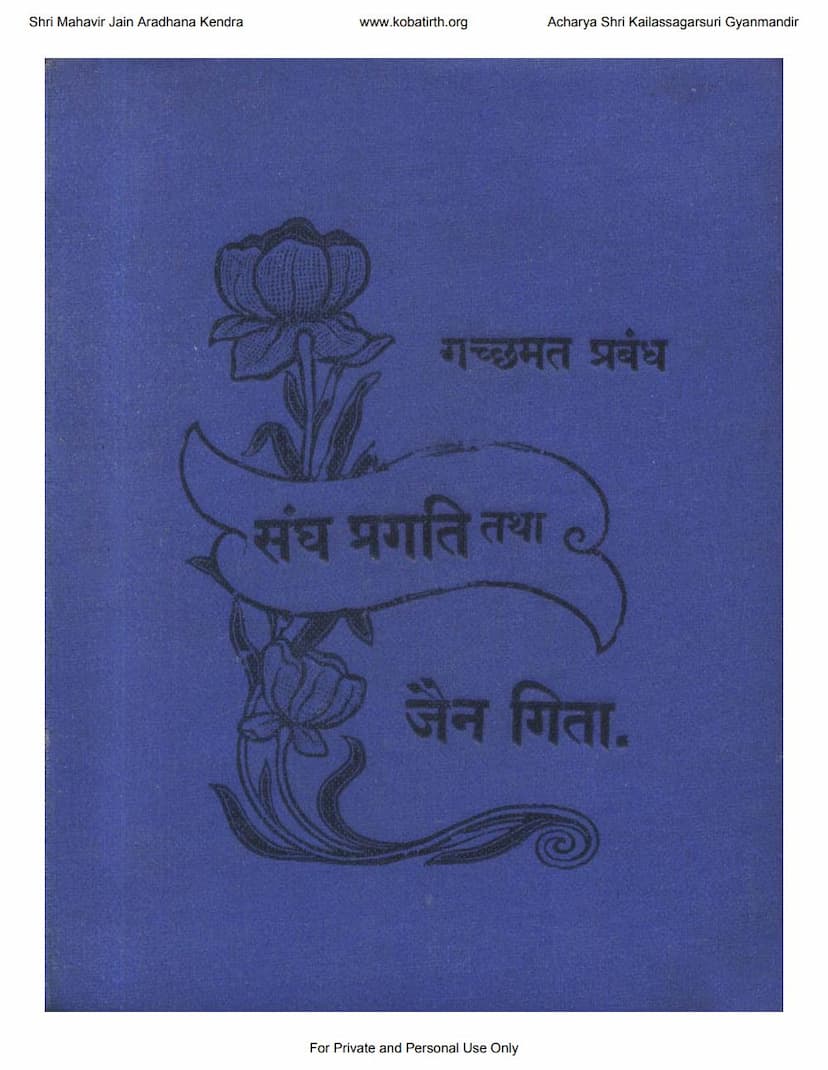Gatchmat Prabandh Jain Geeta
Added to library: September 1, 2025

Summary
This Jain text, titled "Gatchmat Prabandh Jain Geeta" by Buddhisagar, published by Adhyatma Gyan Prasarak Mandal, is a significant historical and philosophical work for the Jain community. The catalog link provided is https://jainqq.org/explore/008567/1.
Here's a comprehensive summary of its content based on the provided pages:
Core Purpose and Content:
The book aims to provide a historical account of the various Gachhas (sects or lineages) within Jainism, their origins, and the philosophies they represent. It seeks to illuminate the progression and evolution of the Jain Sangha (community) over time, emphasizing the importance of unity and adherence to core Jain principles for its advancement.
Key Sections and Themes:
-
Gatchmat Prabandh (On the Management of Sects/Lineages): This section delves into the historical context of the emergence of different Gachhas after Lord Mahavir. It aims to trace their origins, the acharyas who founded them, and the reasons behind their establishment. The author notes that this information is crucial for understanding the historical development and current state of various Jain communities and their geographical distribution. The text acknowledges the difficulty in pinpointing exact dates due to the loss of many historical texts over time but highlights ongoing efforts to compile accurate lineage records (Pattavalis). It also mentions the importance of inscriptions on religious images (Pratima Lekh) for determining the timelines of acharyas.
-
Sangh Pragati (Progress of the Sangha): This section presents valuable insights and appeals to Jain leaders and householders to contribute suggestions for the improvement and progress of the Jain community. It emphasizes the need for careful consideration of the Sangha's advancement.
-
Jain Geeta: This part of the book, originally written in Sanskrit, is included to offer philosophical and spiritual guidance. It is presented as containing valuable ideas for the progress of Jainism and is recommended for every Jain to read.
-
Historical Context and Philosophical Underpinnings:
- The Nature of Sectarianism: The author, Buddhisagar, extensively discusses the natural occurrence of schisms and differing viewpoints (Matbhed) within any religion over time, citing examples from Hinduism, Buddhism, Islam, and Christianity. He attributes these divisions to the inherent diversity of human intellect and perspectives, stating that it's a natural phenomenon that cannot be entirely suppressed.
- Origins of Jain Gachhas: The text explains that Gachhas often arise from the immediate disciples (Ganadharas) of each Tirthankara. It likens the branching of Gachhas to the branches of a tree. The book traces the emergence of differing religious views even from the time of Rishabhadeva and identifies Lord Mahavir's era as a period where various schisms were initiated by his Ganadharas and disciples like Gautama Buddha, Gathala, and Jamali, who introduced their own interpretations.
- Core Jain Beliefs: Despite the formation of numerous Gachhas, the text highlights that the fundamental principles of Jainism, such as the belief in Navatattva (nine realities) and Panchastikaya (five existent substances), remain largely consistent across most Gachhas.
- Geographical Spread and Origins of Gachhas: The book lists various regions like Bengal, Bihar, Kashi, Gujarat, Marwar, Mewar, and Saurashtra as significant centers for Jain religious activity and the origin of many Gachhas. It details the specific locations where certain Gachhas originated, such as Upadesha Gachha in Marwar, Nagil Nivruttikula in Maharashtra, and the Kharatara Gachha in Patan during King Siddharaaj's reign.
- The Role of Acharyas and the Sangha: The text emphasizes the crucial role of Acharyas in establishing, guiding, and preserving the Jain tradition. It stresses that the unity and progress of the Sangha depend on the collective efforts and adherence to the teachings and leadership of the Acharyas.
- The "Chetyavasi" Tradition: A significant portion of the book discusses the Chetyavasi sect, which was prominent in Gujarat, Mewar, and Marwar during the time of the Chavda dynasty kings. These Chetyavasi acharyas held considerable influence as royal gurus. The text notes their adherence to Jain Vedas and Upanishads and their role in establishing Jainism as a state religion.
- Internal Divisions and the Need for Unity: The book acknowledges the existence of internal divisions within the Jain community, such as the divergence between the Svetambara and Digambara traditions, and the numerous Gachhas within each. It laments how inter-sectarian rivalries and debates weakened the Jain community over time, making it vulnerable to external influences. The author strongly advocates for unity among the various Jain sects to ensure the religion's survival and growth.
- The Importance of Knowledge and Practice: The text underscores the need for continuous study of Jain scriptures (Agamas) and the practice of their teachings. It highlights the importance of adhering to the principles of conduct and ethics as laid down by the Tirthankaras and perfected by the Acharyas.
- The Current State of Jainism: The author expresses concern about the declining number of Jains and the lack of unity among them, urging them to overcome internal differences and work collectively for the religion's upliftment.
Key Features and Contributions:
- Detailed Historical Account: Provides a valuable compilation of the lineage and origins of numerous Jain Gachhas, which serves as a crucial historical record.
- Philosophical and Spiritual Guidance: The inclusion of the "Jain Geeta" and the broader discussions on the nature of religious divisions offer profound spiritual and philosophical insights.
- Emphasis on Unity and Progress: The recurring theme of unity and collective action for the progress of the Jain community highlights the author's concern for its future.
- Call to Action: The book implicitly calls for a renewed commitment to Jain principles and a proactive approach towards strengthening the community.
In essence, "Gatchmat Prabandh Jain Geeta" is a foundational text that serves as both a historical chronicle and a spiritual guide, urging the Jain community to understand its past, unite in the present, and work collectively for a prosperous future.